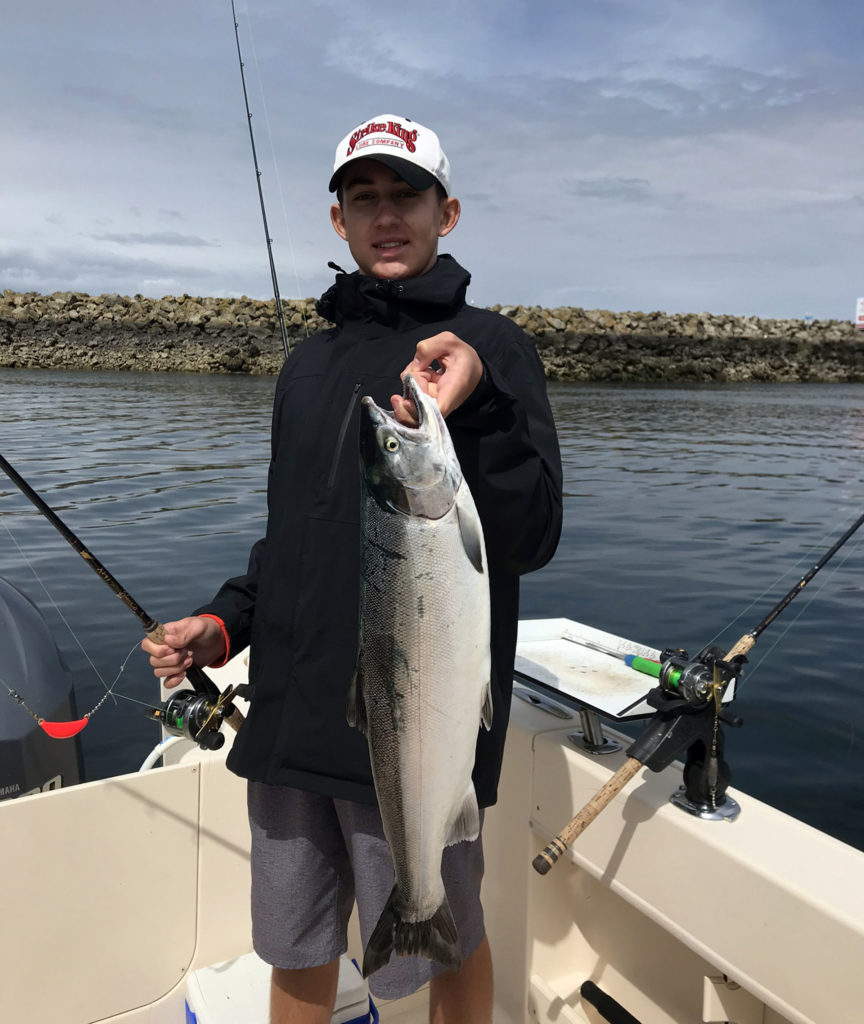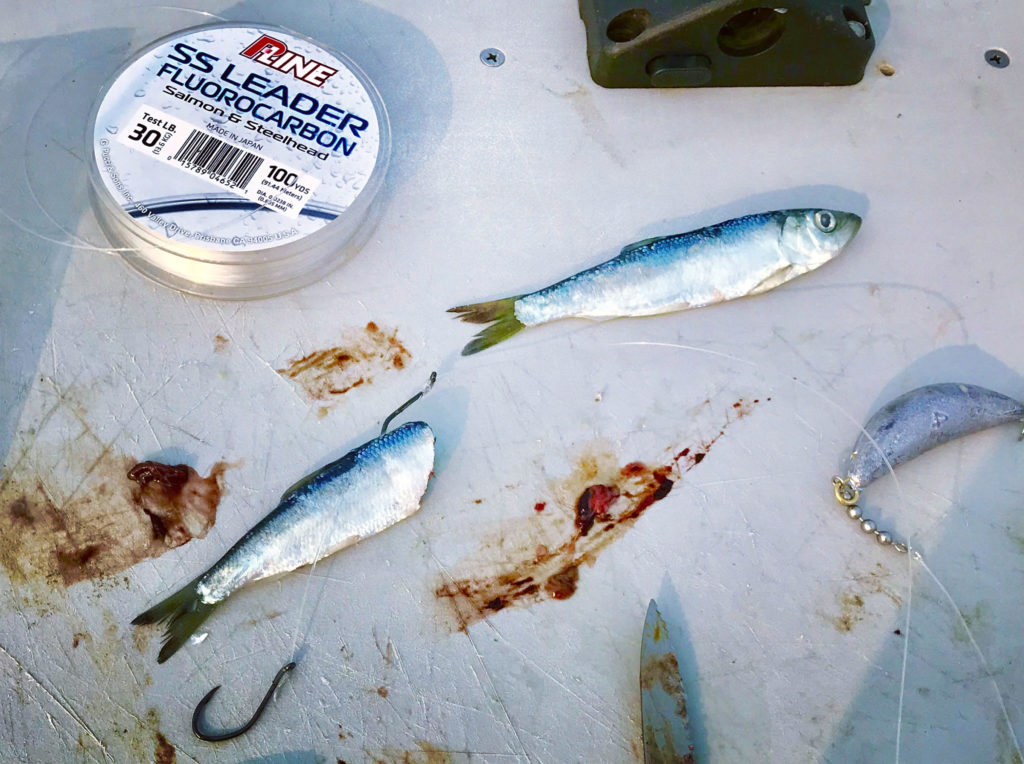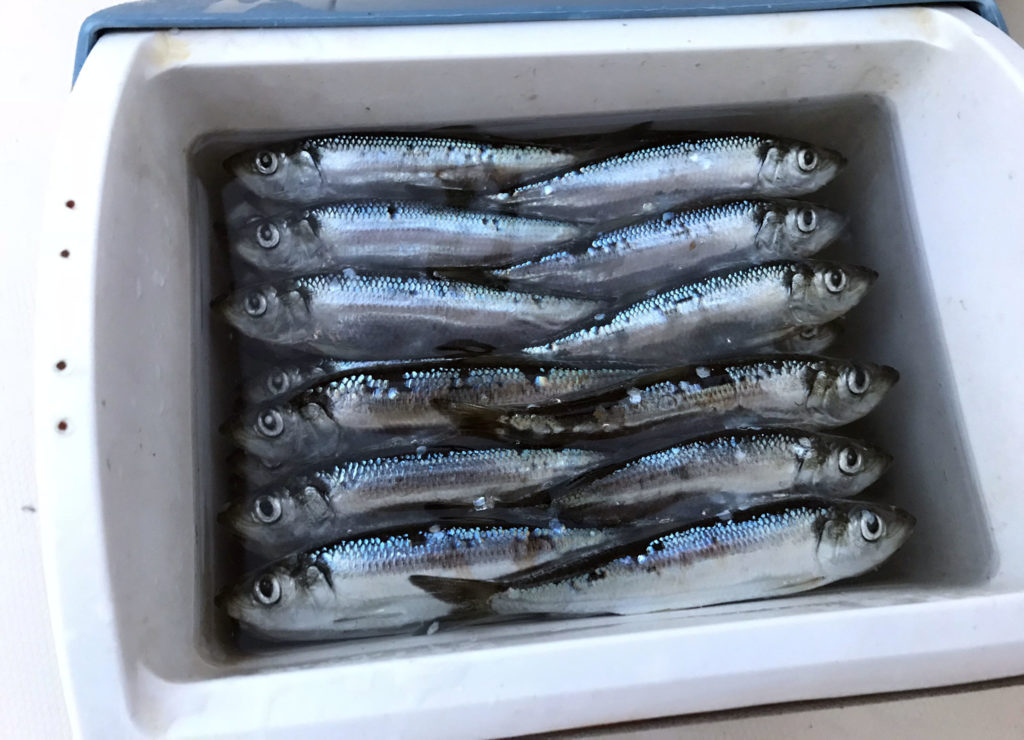Mooching is Puget Sound’s Original Salmon Fishing Method
Mooching has stood the test of time here in Puget Sound. It is one of the oldest salmon fishing techniques that still brings in impressive catches. I prefer mooching over trolling every time I fish Puget Sound. It is super fun and interactive. You get to hold the rod, and work the bait through the entire water column. When a salmon bites, you feel it in with rod-in-hand. There are no rod holders, no captain doing all the work for you. You success is completely in your control.
Puget Sound’s Salmon Mooching Calendar
We can call mooching a year-round technique, respectful of course of the salmon fishing seasons. Anytime that one of Puget Sound’s marine areas are open to salmon fishing, you have a great chance of catching one mooching.
Winter Salmon Mooching in Puget Sound
Resident Chinook live in Puget Sound their whole life. They never migrate out to the ocean, so they are available to catch anytime the season is open. (Which changes area by area, from year to year). Also referred to as Blackmouth, our local Chinook are always on the hunt for forage. Most of the time it is in the form of bottom-hugging Candlefish, or schools of Herring. Work your cut plug herring through the entire water column when bait is suspended. However when bait is not seen on the sonar, you may want to work the bottom portion of the water column. Because there may be a nice Blackmouth cruising the gravel looking for a Candlefish breakfast.

Spring Salmon Mooching in Puget Sound
Our neighborhood Blackmouth grow fatter and fatter into the spring, and by the time our winter season closes or our summer season opens, they could easily tip the scales at 10 pounds or more! By early June, Summer Chinook begin to trickle into the Puget Sound as well, and this is the very beginning of my favorite salmon mooching time… Summer!

Summer Salmon Mooching in Puget Sound
If I could spend every summer day on the water mooching, I would. Summer is a magic time for us moochers. Resident Blackmouth have grown to impressive sizes, and a couple hundred thousand Chinook return from the Ocean. They stop and feed at all the famous mooching haunts. Waiting until the end of summer when their biological clock tells them it’s time to head a little further down the Sound and into the river to spawn.

Fall Salmon Mooching in Puget Sound
September marks a key transition point on the mooching calendar. The excitement of the summer’s Chinook Salmon fishing has wound down, and a flood of Coho Salmon flood into the Sound. They are different from Chinook in many ways, which we will cover below. But the transition in location and tactics makes for a fun wrap up of the salmon season. Fishing for Coho usually stays good until late-September to mid-October, whenever the first major multi-day rainstorm hits, they gone!

Puget Sound Salmon Mooching Tides
Some of the oldest and saltiest Puget Sound moochers still have things to learn about how the tides affect salmon fishing. I’ll try and hit all the high points but the majority of this knowledge can only be gained by time on the water. I use Dairiki Seattle Tides as my online tide chart.
Puget Sound’s Mixed Semi-Diurnal Tides and Salmon Fishing
Semi-Diurnal: Two incoming (flood) tides and two outgoing (ebb) tides each day.
Mixed: The height of the high tides is not the same, the height of the low tides is not the same.

This tide chart is a perfect example of our local mixed semi-diurnal tides. In a 24 hour period we have two high and two low tides. Early morning high is at 1:31am at about 12′ high. Within 6 hours the tide will drop over 12′ to an 8:42am low of about -1′. That’s a huge tide exchange! This means that this morning’s strong ebb currents will push up against underwater land masses and stack up any herring in the area into a concentrated zone. As this morning’s tide continues to ebb, the currents will continue to push the bait.
One of the greatest challenges for any Puget Sound salmon moocher is to find areas where bait is concentrated and follow it as the tides ebb and flood.
The currents will soften as the tide stops ebbing at the 8:42am tide change, and eventually will pick up steam as the afternoon incoming tide floods in. Most likely, the bait in the morning will be in a completely different area during the afternoon flood.
The bigger the tidal exchange, the more concentrated the bait and the faster it will move. Even on a strong tide, we can usually get in hours of fishing a general area before we need to really move around. Weak tides (like this evening’s ebb), will offer us a little more challenge since we probably won’t find massive amounts of bait. But you never know out in the Sound!

Puget Sound Salmon Mooching Locations
The underwater geography of Puget Sound is complex. There are large underwater banks such as Possession off of Whidbey Island, Jeff Head east of Kitsap’s Indianola, Kingston, and Mid Channel Bank near Port Townsend. There are pronounced land points that stick out into the Sound and give us areas where the currents push in concentrations of herring and feeding salmon. Places like Point No Point, Bush Point, West Point, Three Tree Point and Point Defiance. It’s best to find one or two places and spend some time learning how the tides impact where salmon congregate.
Chinook Salmon Mooching Spots in Puget Sound
Here are a few of the most well known mooching spots. If you want to familiarize yourself with where these are located, please visit my post Puget Sound Chinook Salmon Hot Spots for a good map and links to individual locations.

Marine Area 9 Chinook – Admiralty Inlet
The northern entrance to Puget Sound. Close to the ports of Port Townsend, Kingston, Everett and Edmonds. The vast majority of inbound salmon travel through this area to all points south. It offers some fantastic salmon fishing spots. Check out WDFW Admiralty Inlet – Marine Area 9.
- Mid Channel
- Double Bluff
- Point No Point
- Possession Bar
- Pilot Point
Marine Area 10 Chinook – Seattle & Bainbridge Island
Marine Area 10 is Seattle’s backyard. And it gives us some awesome salmon mooching options! Most of these spots are easy to get to if you are launching your boat at Seattle, Edmonds, Kingston, Bremerton or Bainbridge Island. Check out WDFW Seattle-Bremerton Area – Marine Area 10.
- Jeff Head
- Presidents Point
- Kingston
- Richmond Beach
- Meadow Point
- West Point
- Yeomalt Point
Marine Area 11 Chinook – Tacoma & Vashon Island
South Sound has some great salmon fishing, and mooching has been a stronghold here for about the last hundred years. If your boating from Gig Harbor, Tacoma, Des Moines or Vashon, you can easily hit some great spots close to home. Check out WDFW Tacoma-Vashon Island – Marine Area 11.
- Dolphin Point
- Robinson Point
- Dalco
- Three Tree Point
- Redondo
- Point Defiance
- Gig Harbor
Marine Area 13 Chinook – Deep South Sound: Olympia, Case Inlet and Fox Island
I haven’t spent nearly enough time this far south. But Marine Area 13 definitely deserves an honorable mention on this mooching guide! As Chinook push past Point Defiance and the Tacoma Narrows, they find land of islands and inlets. There are large returns to the rivers of Nisqually and Deschutes nearby. Check out WDFW South Puget Sound – Marine Area 13.
Coho Salmon Mooching Spots in Puget Sound
Coho Salmon can be found in Puget Sound year-round, just like Chinook. The Sound’s Resident Coho start the year as juveniles in the South Sound. By June they migrate northward in to Marine Areas 9 and 10 and reach 2-4 pounds. This is usually when we start to target them mooching. They feed aggressively and grow all summer long. By September they are 5 to 8 pounds. By late August, the very first push of Ocean Coho move into Puget Sound, adding to the mix.
Marine Area 9 Coho – Admiralty Inlet
Coho can be found out in the shipping lanes in the middle of Admiralty Inlet, but also travel along the beaches of Whidbey Island. Creating a double whammy of mooching fun. You can fish in the open water or tuck in shallow along the beaches to target these fish.
- Fort Casey State Park
- Bush Point
- Lagoon Point
- Possession Bar
- Shipping Lanes anywhere
- Point No Point
Marine Area 10 Coho – Seattle & Bainbridge Island
Fishing can be great in Marine Area 10 for Resident and Ocean Coho Salmon. Mooching along the top or drop offs of Jeff Head is my go-to, but they can be found just about anywhere!
- Jeff Head
- Outer Kingston Bar
- Meadow Point
- West Point
- Shipping Lanes anywhere

Puget Sound Salmon Mooching Gear
Mooching is a simple technique. You need to equip yourself some basic tackle and quality bait.
- Mooching Rod: 8′ to 10’6″ rod with a 8-17 pound to 10-20 pound line rating.
- Mooching Reel: Most use a conventional level wind reel with a line counter.
- Fishing Line: 15 pound to 20 pound hi-viz monofilament.
- Mooching Sinkers: 2 ounce to 6 ounce mooching sinkers, I primarily use 3 ounce to 4 ounce in Puget Sound.
- Herring Leader: 20 pound to 30 pound leader, 4′ to 8′ length, tied with 2/0 to 4/0 tandem octopus hooks.
- Bait: Red Label or Green Label sized trays of frozen herring. Usually 1-3 trays per person for a days’ worth of bait.
- Tools: Bait cutting knife, pliers to pinch barbs (barbless hooks are required), a net and a release tool. If you want help with cutting bait, a bait cutting guide can be handy.

Best Bait for Mooching
Herring is the main forage for Puget Sound Chinook and Coho Salmon. So naturally that is what we use for mooching. It’s most commonly sold frozen at local tackle shops. We used to have a few places where live herring could be purchased early in the morning. Nowadays, fresh herring is difficult to come by. If you want some added fun, bring a second rod with you and use a Sabiki set-up to catch live herring out there.
Herring Care
Herring is fragile and we want the bait to last all day when fishing. I usually fill a small cooler with seawater and allow the frozen herring to thaw and brine in that as I run out in the morning. If you are mooching and using a fair amount of bait, usually adding a new tray of frozen herring to the cooler will keep everything chilled. When the weather is hot, I like to have a small ice pack in the cooler to keep the bait from getting warm and soft.
You can also brine the herring the night before if you wish. For a pre-made mixture, I really like Pro Cure Brine N Bite. Check out The Best Herring Brine Recipe and Helpful Tips for Brining Herring.


How to Mooch!
Mooching is essentially dropping a cut plug herring down to the desired depth and reeling it back up. As the bait drops and lifts through the water column, it spins and gives an attractive presentation that salmon can’t resist!
To get more into the mooching technique, check out Master the Art of Salmon Mooching.
While any salmon can be found at any depth in the water column feeding on bait, I have a few pointers when targeting Chinook versus Coho in Puget Sound…
Chinook Salmon Mooching in Puget Sound
I have found most of my Chinook mooching success by keying in on all that great underwater structure that we talked about earlier. If I am able to find a good amount of bait with my sonar, I’ll work the entire water column. A Chinook might be feeding on a herring bait ball at 70 feet but may follow your cut plug down to 150′, away from the bait, before committing to bite. Likewise, I’ve worked a deep water bait ball at 200′ and had Chinook follow the bait to 10′ under the boat before biting! It’s such a mystery sometimes, but that is what makes it so fun!
Coho Salmon Mooching in Puget Sound
Coho Salmon tend to be more surface oriented. When I’m out mooching in the shipping lanes, the water could be over 600′ deep but I will only work the top 50′ to 100′ of the water column. When it gets a little breezy, Coho mooching can really turn on. Because, even when you let out 100′ of line, the boat may be drifting fast enough to keep your bait from getting too deep. When it’s really windy, I swear that my bait never gets more than 20′ below the surface even if I let out 150′ feet of line. Sometimes Coho will be found deeper though. And I’ve had banner days with no wind, where we caught Coho 100′ down.

Puget Sound Mooching: Lessons Learned!
You could mooch for fifty years and still learn something new everyday! Here are a few mentionables that I think could help you.
- Tangles happen. Your spinning cut plug can cause your leader to twist around the mainline as you drop it. Make sure that when you start to drop, your herring and sinker aren’t right next to eachother. No wind makes for more tangles. If you are getting constantly tangled, switch to a lighter sinker and slow down the speed of the drop.
- Losing Salmon happens. Salmon fight you in a way that is unique to all the other species in Puget Sound. They will usually bite and swim to the surface during the battle. It’s important to recover as much line as possible before they slack you out. Also important is to not have the drag set too tight, or else they can break the main with a vicious head shake. I don’t rush the battle. But please do make sure you keep the line tight and the rod bent until they are tired enough to lead into the net.
- Dogfish happen. Spiny Dogfish are a small shark that infest Puget Sound during summer months. By the way, they love eating herring. Sometimes you can’t completely avoid catching them but you can find ways to help the situation. Never let your bait sit still and keep it spinning. If you are dropping deep and start catching Dogfish, shallow it up and don’t drop as deep! Sometimes they are so thick the only hope is to switch locations.
- Seals stealing fish happens. The Puget Sound has a healthy population of Harbor Seals. I usually fish around them, but rarely have them steal our catch. Although keeping the crew calm and keeping the net down until the last moment helps to avoid their attention. They love hearing fishermen yell, “Fish On!”.













 Canary Rockfish – The Golden Beauty of the Pacific
Canary Rockfish – The Golden Beauty of the Pacific
